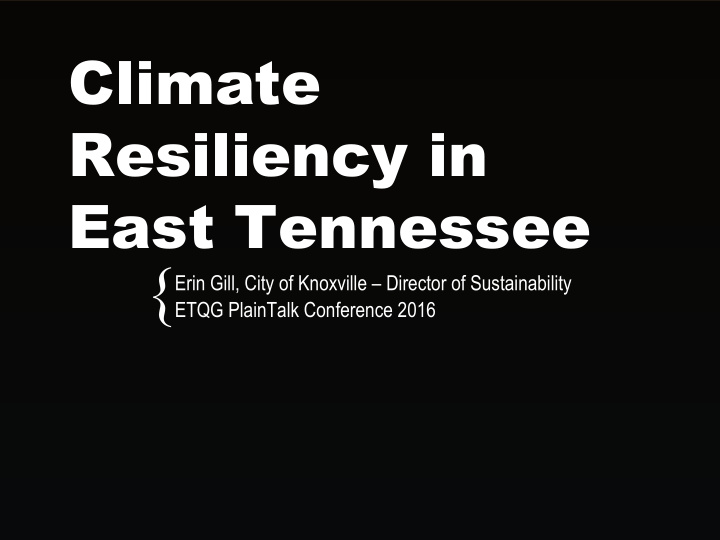



Climate Resiliency in East Tennessee { Erin Gill, City of Knoxville – Director of Sustainability ETQG PlainTalk Conference 2016
Sustainability …the ability to meet our current needs without compromising the ability of future generations to meet their needs.
Preparedness …a state of readiness to respond to a disaster, crisis, or any other type of emergency situation. Preparedness
Resilience …capacity of individuals, communities, institutions, businesses, and systems within a city to survive, adapt, and grow no matter what kinds of chronic stresses and acute shocks they experience. - 100 Resilient Cities
Our Region Faces Many Stresses • East Tennessee • Aging Infrastructure •Lack of Affordable Housing •HazMat Accidents •Changing Demographics •Health Crises •Air Quality •Congestion •Legislative Changes
Plan East Tennessee Regional Playbook
Tennessee Department of Transportation, www.tdot.tn.gov
ET Index Livability Report Card 2015, Knoxville-Knox County Metropolitan Planning Commission
ET Index Livability Report Card 2015, Knoxville-Knox County Metropolitan Planning Commission
ET Index Livability Report Card 2015, Knoxville-Knox County Metropolitan Planning Commission
Some Stresses are Related to Climate & Weather • East Tennessee •Flooding •Drought •Severe Storms •Heat •Water Availability •Tornados •Pests •Erosion/ Runoff
Photo Credit: http://www.enr.com/articles/39001-tennessee-rockslides-close-interstate-75-in-both-directions
Photo Credit: http://wate.com/2015/02/17/kub-works-around-the-clock-to-restore-power-to-thousands-after-mondays-ice-storm/
Photo Credit: http://wate.com/2015/05/04/tornado-warnings/
Photo Credit: Knoxville News Sentinel, 2011
Photo Credit: The Mountain Press, What’s Eating the Park, July 19, 2014
Our Region’s Climate is Changing
The Changing Climate Will Deepen Challenges We Already Face
Oak Ridge National Laboratory
2014 National Climate Assessment
Hotter Summers • Heat-related health impacts • Increased allergens and pollutants (including ozone) • Increased and new pest populations • Unwanted spread of non-native species • Reduced agricultural productivity • Reduced labor productivity • Increased energy use and utility costs
Oak Ridge National Laboratory
2014 National Climate Assessment
Warmer Winters • Increased winter precipitation • Increased and new pest populations • Unwanted spread of non-native species
Oak Ridge National Laboratory
2014 National Climate Assessment
More Extreme & Variable Precipitation Events • Increased risk for flooding • Strain on water management systems • Potential for drinking water access issues and conflicts • Increased financial costs from stronger, more frequent storm events
Because of Climate Change, Will… • More families struggle with the cost of energy or home repairs? • Tourism be impacted? • Infrastructure costs be higher? • Population increase faster (or more) than expected? • More businesses want to locate here? • Worker productivity decrease? • Global changes disrupt local supply chains?
The Reality is: • Our region has some natural buffers to potential risks. • But, we’re not invincible. • And, we can be affected by conditions elsewhere. • We can’t predict conditions on any given day. • But, we do know trends. And conditions are changing. • Many of our systems are working well. • But, business as usual may not be sufficient. Proactive, cross-system planning is an imperative, not an option.
How Do We Build Resilience? • Understand climate & non-climate stresses • Identify where municipal systems and communities are vulnerable • What can we learn from the past, or from regional experiences? • Evaluate & pursue strategies to: • Reduce vulnerabilities • Increase adaptive capacity This is a job for all of us. BUT, we also must think across systems .
Resilience Thinking Allows Us to Find Win-Wins • Emergency Responder Training & Innovation • Neighborhood Disaster Preparedness Program • Tree Canopy Expansion & Diversification • Energy Efficiency Programming for Vulnerable Citizens • Green Infrastructure Use • 311 Property Damage Claim Aggregation
Resiliency Example: Urban Forestry Tree Canopy Improves Resiliency - Reduces stormwater runoff, erosion - Reduces heating/cooling costs - Abates Urban Heat Island effects - Improves air quality - Increases wildlife habitat Resilient Tree Planting Don’t just plant for aesthetics. Plant to maximize multiple benefits. Plant to withstand stresses.
Take Away Themes • Anticipate Requirements. • Federal programs are beginning to require climate considerations for funding, approvals. • Look ahead, not back. • Yesterday’s experiences (and weather) may not reflect the future. • Emphasize win-wins. • Address resiliency alongside other needs, opportunities. • Think across systems. • What vulnerabilities or opportunities exist beyond your organization? Beyond your city? • Leverage existing (and free!) resources. • US Climate Resilience Toolkit: https://toolkit.climate.gov/ Data • Planning tools • Case studies •
Questions & Discussion Thank you! Erin Gill Director of Sustainability City of Knoxville 865-215-4430 | egill@knoxvilletn.gov
Recommend
More recommend